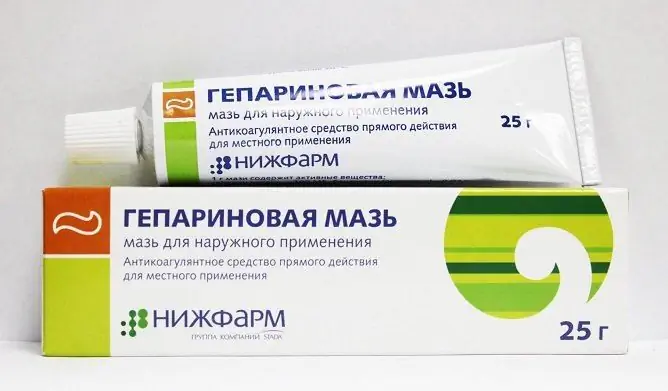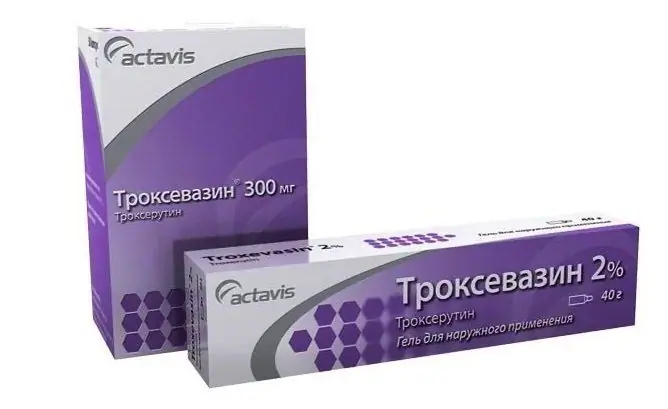- Author Rachel Wainwright [email protected].
- Public 2023-12-15 07:39.
- Last modified 2025-11-02 20:14.
Fraxiparine
Fraxiparine: instructions for use and reviews
- 1. Release form and composition
- 2. Pharmacological properties
- 3. Indications for use
- 4. Contraindications
- 5. Method of application and dosage
- 6. Side effects
- 7. Overdose
- 8. Special instructions
- 9. Application during pregnancy and lactation
- 10. Use in childhood
- 11. In case of impaired renal function
- 12. Use in the elderly
- 13. Drug interactions
- 14. Analogs
- 15. Terms and conditions of storage
- 16. Terms of dispensing from pharmacies
- 17. Reviews
- 18. Price in pharmacies
Latin name: Fraxiparine
ATX code: B01AB06
Active ingredient: nadroparin calcium
Producer: GLAXO WELLCOME PRODUCTION (France)
Description and photo updated: 2018-26-11
Prices in pharmacies: from 2337 rubles.
Buy

Fraxiparine is a direct-acting anticoagulant.
Release form and composition
Fraxiparine is available in the form of a solution for subcutaneous (subcutaneous) administration: a transparent or slightly opalescent liquid, colorless or light yellow (at a dose of 0.3 ml, 0.4 ml, 0.6 ml, 0.8 ml or 1 ml in glass disposable syringes, 2 syringes in a blister, in a cardboard box of 1 or 5 blisters).
1 ml of solution contains:
- active substance: calcium nadroparin - 9500 ME (international unit) anti-Xa;
- auxiliary components: calcium hydroxide solution (or dilute hydrochloric acid), water for injection.
In 1 syringe, the calcium content of nadroparin depends on its volume and corresponds to the following amount:
- volume 0.3 ml - 2850 ME anti-Xa;
- volume of 0.4 ml - 3800 ME anti-Xa;
- volume 0.6 ml - 5700 ME anti-Xa;
- volume 0.8 ml - 7600 ME anti-Xa;
- volume of 1 ml - 9500 ME anti-Ha.
Pharmacological properties
Pharmacodynamics
Fraxiparine is a direct-acting anticoagulant. Its active ingredient is calcium nadroparin. It is a low molecular weight heparin obtained from standard heparin by depolymerization. It is a glycosaminoglycan with an average molecular weight of 4300 daltons.
The high ability of nadroparin calcium to bind to the blood plasma protein antithrombin III (AT III) causes an accelerated inhibition of blood coagulation factor (Xa), causing the manifestation of its high antithrombotic potential.
In addition, the antithrombotic effect of nadroparin is due to such mechanisms as activation of the tissue factor transformation inhibitor (TFPI), activation of fibrinolysis by direct release of tissue plasminogen activator from endothelial cells, and modification of the rheological properties of blood. The change in the properties of blood consists in a decrease in its viscosity, an increase in the permeability of the membranes of platelets and granulocytes.
For nadroparin calcium, a higher anti-Xa factor activity is characteristic when compared with anti-IIa factor or antithrombotic activity. It has both immediate and prolonged antithrombotic effects.
Nadroparin has a mild effect on primary hemostasis.
Prophylactic doses of Fraxiparine do not cause a pronounced decrease in activated partial thromboplastin time (APTT). During the course of therapy, the APTT value can increase by 1.4 times compared with the standard indicator during the period of maximum drug activity. This is a reflection of the residual antithrombotic effect of calcium nadroparin.
Pharmacokinetics
The determination of pharmacokinetic properties is based on changes in the anti-Xa-factor activity of plasma.
After subcutaneous administration, up to 88% of nadroparin is absorbed, the maximum anti-Xa activity (C max) is achieved in 3-5 hours. With intravenous administration, C max occurs in less than 1/6 hour.
In the liver, it is metabolized to a greater extent by depolymerization and desulfation.
T 1/2 ( half-life) with intravenous administration is about 2 hours, with s / c - about 3.5 hours. At the same time, anti-Xa activity after subcutaneous administration at a dose of 1900 IU of anti-Xa remains for at least 18 hours.
In elderly patients, dose adjustment is made in accordance with age-related physiological deterioration in renal function.
When prescribing Fraxiparine for the treatment of unstable angina pectoris, myocardial infarction without a Q wave or thromboembolism in patients with mild or moderate renal failure with creatinine clearance (CC) from 30 ml / min to 60 ml / min, the dose of the drug should be reduced by 25%. The appointment is contraindicated in patients with severe renal failure.
For the prevention of thromboembolism in patients with mild or moderate renal failure, a dose reduction of nadroparin is not required, with severe renal failure, the dose must be reduced by 25%.
The injection of high doses of low molecular weight heparin into the arterial line of the dialysis loop prevents blood clotting in the dialysis loop. In case of an overdose, the entry of Fraxiparine into the systemic circulation can cause an increase in anti-Xa factor activity associated with the end phase of renal failure.
Indications for use
- thromboembolism;
- unstable angina;
- myocardial infarction without Q wave;
- prevention of thromboembolic complications during surgery and orthopedic interventions;
- prevention of thrombus formation in the intensive care unit in patients with acute respiratory and / or heart failure;
- prevention of blood clotting during a hemodialysis session.
Contraindications
- thrombocytopenia with a history of nadroparin use;
- intracranial hemorrhage;
- signs of bleeding, increased risk of bleeding in case of impaired hemostasis (except for disseminated intravascular coagulation syndrome, not caused by heparin);
- acute gastric and / or duodenal ulcer and other organic lesions of organs prone to bleeding;
- acute septic endocarditis;
- surgical interventions or injuries to the eyes, spinal cord or brain;
- breast-feeding;
- age up to 18 years;
- hypersensitivity to the components of Fraxiparine.
In addition, the use of the solution is contraindicated for the treatment of thromboembolism, unstable angina pectoris or myocardial infarction without a Q wave in patients with severe renal failure (CC less than 30 ml / min).
It is not recommended to prescribe Fraxiparine during pregnancy, with the exception of those cases when, according to the doctor, the benefits of therapy to the mother outweigh the possible risk to the fetus.
According to the instructions, Fraxiparine should be used with caution when indicating a history of peptic ulcers or other diseases with an increased risk of bleeding, hepatic and / or renal failure, severe hypertension, circulatory disorders in the retina and choroid of the eye, in combination with drugs that increase the risk of bleeding, the use of the drug during the period after surgery on the brain and spinal cord or on the eyes, the patient's body weight is less than 40 kg, in situations where treatment must be continued for more than 10 days, in case of violation of the recommendations for use, especially if they are related to the duration and inappropriate dose to the patient's body weight.
Instructions for the use of Fraxiparine: method and dosage
The solution is injected subcutaneously into the abdominal tissue (anterolateral or posterolateral area of the surface) from the right and left sides alternately. It is advisable to perform the procedure in a horizontal position of the patient. The introduction of Fraxiparine into the thigh is allowed.
Do not remove air bubbles from the syringe before injection to prevent loss of the drug.
For the introduction of Fraxiparine, it is necessary to form a fold of skin with the thumb and forefinger and hold it during the entire period of administration of the solution. The needle is inserted perpendicular (not at an angle) to the surface. After injection, do not rub the injection site.
Recommended dosage:
- prevention of thromboembolism during surgical interventions: Fraxiparine 0.3 ml (2850 ME anti-Xa) 2-4 hours before surgery, then once a day during the entire period of increased risk of thrombus formation. Course duration - at least 7 days;
- prevention of thromboembolism in orthopedic operations: at the rate of 38 IU anti-Xa per 1 kg of patient weight. The first dose is administered 12 hours before the operation, the second 12 hours after it. Further, injections are performed once a day during the entire period of increased risk of thrombus formation and until the patient switches to outpatient treatment. On the fourth day after the operation, the dose can be increased, but not more than 50%. The minimum course of therapy is 10 days;
- prevention of thrombus formation in the intensive care unit in patients with respiratory tract infections, acute respiratory and / or heart failure: at a dose of 0.4 ml for a patient's body weight up to 70 kg, 0.6 ml for a patient weighing more than 70 kg. Fraxiparine is prescribed 1 time per day. The doctor determines the duration of the course individually.
In the treatment of myocardial infarction without Q wave and unstable angina pectoris, the first dose is administered intravenously (iv) bolus, subsequent doses - s / c with an interval of 12 hours for 6 days. Shown is a combination of Fraxiparine with 325 mg of acetylsalicylic acid per day. A single dose for intravenous and subcutaneous administration is determined at the rate of 86 IU anti-Xa per 1 kg of patient weight.
Recommended dosage for intravenous (initial dose) and s / c (for subsequent injections) administration of Fraxiparine in the treatment of myocardial infarction without Q wave and unstable angina pectoris, taking into account the patient's weight:
- less than 50 kg: 0.4 ml;
- 50-59 kg: 0.5 ml;
- 60-69 kg: 0.6 ml;
- 70-79 kg: 0.7 ml;
- 80-89 kg: 0.8 ml;
- 90-99 kg: 0.9 ml;
- 100 kg and above: 1 ml.
In the treatment of thromboembolism, the recommended dosage is 86 IU anti-Xa per 1 kg of body weight 2 times a day. The duration of the course is 10 days. In the absence of contraindications, oral anticoagulants should be administered as early as possible. The use of Fraxiparine is continued until the target prothrombin time is reached.
The dose of the drug in the treatment of thromboembolism should be in the following accordance with the patient's body weight:
- less than 50 kg: 0.4 ml;
- 50-59 kg: 0.5 ml;
- 60-69 kg: 0.6 ml;
- 70-79 kg: 0.7 ml;
- 80-89 kg: 0.8 ml;
- 90 kg and above: 0.9 ml.
The dose of Fraxiparine in order to prevent blood coagulation during hemodialysis in the extracorporeal circulation system is set individually, taking into account the technical conditions of dialysis. The solution is injected into the arterial line of the dialysis loop once at the beginning of the session.
Recommended dosage for patients without an increased risk of bleeding:
- less than 50 kg: 0.3 ml;
- 50-69 kg: 0.4 ml;
- 70 kg and above: 0.6 ml.
For patients with a high risk of bleeding, use half the recommended dose, but sufficient for a dialysis session.
If the session duration is more than 4 hours, additional administration of a small dose of Fraxiparine is possible. The procedure should be accompanied by careful monitoring of the patient's condition due to possible thrombus formation in the dialysis system or bleeding.
Taking into account the observed effects during the first dialysis session, the dose of the drug for the following procedures can be adjusted.
No special dose adjustment is required for elderly patients.
When using Fraxiparine for the prevention of thrombus formation in patients with renal insufficiency, dose reduction is not required with CC 30-60 ml / min, with CC less than 30 ml / min - the dose should be reduced by 25%.
For the treatment of thromboembolism, unstable angina pectoris and myocardial infarction without Q wave in patients with CC 30-60 ml / min, the dose is reduced by 25%, patients with CC less than 30 ml / min Fraxiparine cannot be prescribed.
Side effects
- on the part of the blood coagulation system: very often - bleeding of various localizations (more often in the presence of other risk factors);
- from the hematopoietic system: rarely - thrombocytopenia; very rarely - transient eosinophilia;
- from the immune system: very rarely - hypersensitivity reactions in the form of skin rashes, Quincke's edema;
- on the part of the hepatobiliary system: often - an increase in the activity of hepatic transaminases (more often of a transient nature);
- local reactions: very often - small hematomas at the injection site; very rarely - skin necrosis at the injection site; in some cases, the appearance of dense nodules (not encapsulating heparin), which disappear after a few days;
- others: very rarely - priapism, reversible hyperkalemia (more often in patients at risk).
Overdose
Symptoms: bleeding, impaired platelet count and other parameters of the blood coagulation system.
Treatment: with minor bleeding, it is sufficient to reduce the next dose of Fraxiparine or to delay its administration. The appointment of special therapy is required in severe cases. Protamine sulfate has a pronounced neutralizing effect on the anticoagulant effect of heparin. When calculating the dose of the antidote, it should be borne in mind that 0.6 ml of protamine sulfate is needed to neutralize 950 ME of anti-Xa nadroparin. It is possible to reduce the dose of the antidote if a long period has passed after the overdose.
special instructions
Do not inject the drug intramuscularly!
During the period of treatment with Fraxiparine, its alternation with other drugs belonging to the class of low molecular weight heparin is unacceptable. This is due to the possible violation of the prescribed dosage regimen due to the use of dosage units different from the drug.
Graduated syringes allow you to accurately select an individual dose, taking into account the patient's body weight.
Signs of necrosis at the injection site are usually purpura, a painful erythematous or infiltrated spot (including general symptoms). If they appear, you should stop using Fraxiparine immediately.
Heparins increase the risk of thrombocytopenia, therefore, treatment should be accompanied by careful monitoring of platelet count. Special care should be taken, and if the following conditions appear, immediately discontinue treatment: thrombocytopenia, a pronounced decrease (by 30-50% of the initial value) in the number of platelets, negative dynamics from the side of thrombosis, about which therapy is being conducted, thrombosis that developed during the administration, syndrome of disseminated intravascular coagulation.
If necessary, it is possible to prescribe Fraxiparine to patients with an indication of a history of heparin-induced thrombocytopenia arising from the use of unfractionated or low molecular weight heparins. In this case, a daily platelet count is shown. If thrombocytopenia occurs, you should immediately stop using the drug and consider prescribing anticoagulants of other groups.
The appointment of Fraxiparine should be made only taking into account the results of the assessment of renal function.
Against the background of the use of heparin in patients with an elevated level of potassium in the blood or the risk of an increase in the concentration of potassium in the blood, the likelihood of hyperkalemia increases. In this regard, with a long course of therapy or treatment of patients with chronic renal failure, diabetes mellitus, metabolic acidosis or being on concomitant therapy with angiotensin-converting enzyme (ACE) inhibitors, non-steroidal anti-inflammatory drugs (NSAIDs) and other drugs that contribute to the development of hyperkalemia, it is necessary to carefully monitor the level of potassium in the blood.
The decision on the possibility of combining anticoagulants with neuraxial blockade is made individually based on an assessment of the balance of benefits and risks of this combination.
When performing spinal and epidural anesthesia or lumbar puncture, it is required to observe the interval between drug administration and the introduction or removal of a spinal or epidural needle or catheter. When using Fraxiparine for the prevention of thromboembolism, it is at least 12 hours, for the purpose of treatment - 24 hours. In renal failure, the interval may be increased.
Application during pregnancy and lactation
It is not recommended to prescribe Fraxiparine during pregnancy and lactation. The use of the drug during pregnancy is possible only in cases where the expected effect of therapy for the mother outweighs the potential threat to the fetus.
Pediatric use
It is contraindicated to prescribe Fraxiparine for the treatment of children under the age of 18 years.
With impaired renal function
For the treatment of thromboembolism, unstable angina pectoris or myocardial infarction without a Q wave, the appointment of nadroparin calcium solution is contraindicated in patients with severe renal failure (CC less than 30 ml / min). When CC is 30-60 ml / min, the dose is reduced by 25%.
When using Fraxiparine for the prevention of thrombus formation in patients with renal insufficiency, a dose reduction is not required with a CC of 30-60 ml / min, with CC less than 30 ml / min - it should be reduced by 25%.
Use in the elderly
No special dose adjustment is required for elderly patients.
Drug interactions
With the simultaneous use of Fraxiparine:
- unfractionated or low molecular weight heparins, potassium-sparing diuretics, potassium salts, angiotensin II receptor blockers, cyclosporine, tacrolimus, trimethoprim, ACE inhibitors, NSAIDs: increase the risk of hyperkalemia;
- drugs that affect hemostasis (indirect anticoagulants, dextran, fibrinolytics, acetylsalicylic acid, NSAIDs): cause mutual enhancement of action;
- acetylsalicylic acid (at a dose of 50-300 mg for cardiological or neurological indications), abciximab, clopidogrel, beraprost, iloprost, eptifibatide, tirofiban, ticlopidine: have an effect on increasing the risk of bleeding;
- indirect anticoagulants, dextrans, systemic glucocorticosteroids: should be used with caution. After the appointment of indirect anticoagulants, the use of Fraxiparine should be continued until the required MHO (international normalized ratio) is reached.
Analogs
Fraxiparine analogs are: Fraxiparin Forte, Atenative, Fragmin, Wessel Douet F, Kleksan, Heparin, Heparin-Darnitsa, Heparin-Biolek, Heparin-Indar, Heparin-Pharmex, Heparin-Novopharm, Novoparinoksa, Tsibor, Eoxin.
Terms and conditions of storage
Keep out of the reach of children.
Store at temperatures up to 30 ° C, do not freeze.
The shelf life is 3 years.
Terms of dispensing from pharmacies
Dispensed by prescription.
Reviews about Fraxiparine
Reviews of Fraxiparine are mostly positive. Patients indicate its effectiveness when used to prevent thrombus formation after surgery, in diagnosing increased blood clotting during pregnancy, and in thromboembolism. The positive dynamics of the drug's action is reflected by the results of laboratory tests.
Fraxiparine price in pharmacies
The price of Fraxiparine 0.3 ml for a package containing 10 syringes can range from 2,497 rubles, in a dose of 0.4 ml - from 2,672 rubles.
Fraxiparine: prices in online pharmacies
|
Drug name Price Pharmacy |
|
Fraxiparine 9500 anti-Xa IU / ml solution for subcutaneous administration 0.3 ml 10 pcs. 2337 RUB Buy |
|
Fraxiparine 9500 anti-Xa IU / ml solution for subcutaneous administration 0.4 ml 10 pcs. 3510 RUB Buy |
|
Fraxiparine 9500 anti-Xa IU / ml solution for subcutaneous administration 0.6 ml 10 pcs. 3583 RUB Buy |
|
Fraxiparine 9500 anti-Xa IU / ml solution for subcutaneous administration 0.8 ml 10 pcs. 4566 RUB Buy |

Maria Kulkes Medical journalist About the author
Education: First Moscow State Medical University named after I. M. Sechenov, specialty "General Medicine".
Information about the drug is generalized, provided for informational purposes only and does not replace the official instructions. Self-medication is hazardous to health!






